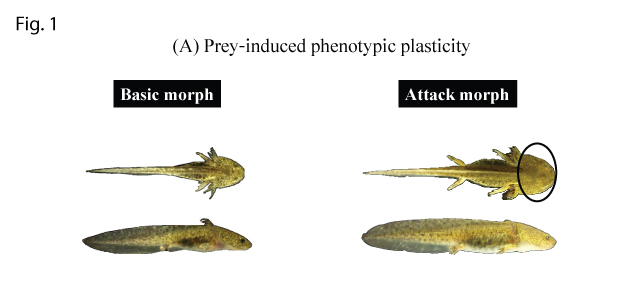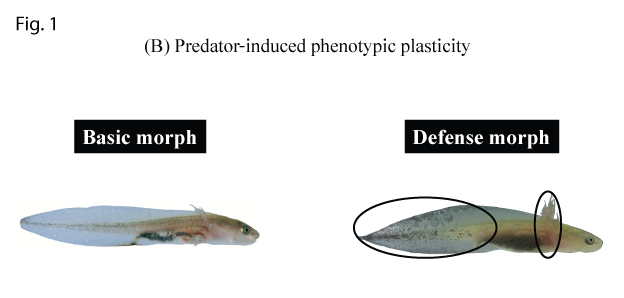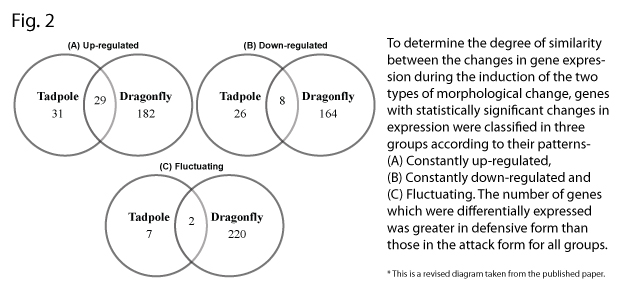Molecular Mechanism of Phenotypic Plasticity in Salamanders Partially Identified
Research Press Release | June 26, 2015
-
 Figure 1. Prey and predator induced phenotypic plasticity in Hokkaido salamander larvae: (A) A tadpole prey induced attack morph with a broader head which is advantageous for catching prey.
Figure 1. Prey and predator induced phenotypic plasticity in Hokkaido salamander larvae: (A) A tadpole prey induced attack morph with a broader head which is advantageous for catching prey. -
 Figure 1. Prey and predator induced phenotypic plasticity in Hokkaido salamander larvae: (B) A dragonfly nymph predator induced defensive morph with larger external gills and tail fin for greater protection from predators.
Figure 1. Prey and predator induced phenotypic plasticity in Hokkaido salamander larvae: (B) A dragonfly nymph predator induced defensive morph with larger external gills and tail fin for greater protection from predators. -
 Figure 2. The number of differentially expressed genes in the brain
Figure 2. The number of differentially expressed genes in the brain
| Press Release | ||
|---|---|---|
| Key Points | ・Phenotypic plasticity in salamanders was induced by introducing the presence of predators, such as dragonfly nymphs, and by the presence of prey, such as tadpoles; the expressed genes were fully decoded.
・Change in gene expression due to phenotypic plasticity induced by predators occurred approximately five times more than those induced by prey. ・The same molecular mechanism was found to be involved even in different morphological changes. ・The results from this study provide important clues to understanding how organisms are affected by the surrounding ecosystem and how morphogenesis is induced and evolves. |
|
| Overview | Hokkaido salamander (Hynobius retardatus) larvae flexibly change form according to their environment. When coexisting with prey such as tadpoles, the salamander larvae develop larger heads—facilitating attacking—which is an advantage as a predator (Fig. 1 (A). On the other hand, when coexisting with predators, such as dragonfly nymphs, the salamander larvae develop larger external gills*1 and tail fin to aid in their defense (Fig. 1 (B). What is the mechanism that causes these morphological changes?
To identify the genes that control these changes, we carried out comprehensive gene expression analysis. From the analysis results, the change in gene expression in predator-induced morphological change was approximately five times higher than that in prey-induced morphological change. Moreover, not only was a different change in gene expression observed between different morphological changes, a similar change in gene expression was also observed. Therefore, the ability to make such morphological changes are not thought to have developed independently, but are thought to come from the same latent genes that have the potential for morphological change induction. *1 Filamentous, dendritic or feathery gills protruding from the skin outside the body. This is also commonly observed in urodele amphibians and the fry of some fish species (lungfish, etc.). |
|
| Inquiries |
Masatoshi MATSUNAMI, Research Fellow, Faculty of Environmental Earth Science , Hokkaido University TEL & FAX: +81-11-706-2225 E-mail: mmatsunami@ees.hokudai.ac.jp Toru MIURA, Associate Professor, Faculty of Environmental Earth Science , Hokkaido University TEL & FAX: +81-11-706-4524 E-mail: miu@ees.hokudai.ac.jp |
|
|
Japanese Link |
サンショウウオの形態変化を引き起こす 分子メカニズムの一端を解明 | |
| Publications | Transcriptome analysis of predator- and prey-induced phenotypic plasticity in the Hokkaido salamander (Hynobius retardatus), Molecular Ecology (2015.6.12) | |
